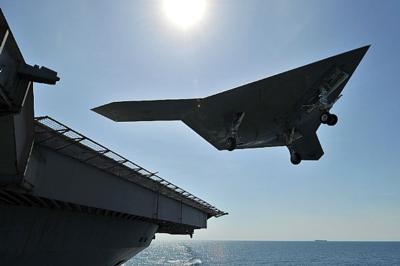Navy Celebrating The 103rd Anniversary Of The Birth Of Naval Aviation
Aero-Commentary By Hill Goodspeed, National Naval Aviation Museum
In outward appearance and the scope of their operations, they seemingly have nothing in common. While the A-1 Triad was constructed of wood and fabric with a top speed that would put it in the slow lane on a modern interstate highway, the X-47B Unmanned Combat Air System represents cutting edge technology. Yet, these aircraft, for what they represent to the development of naval aviation, are quite similar. Seminal moments in their service occurred in May during which the Navy this year celebrates the 103rd birthday of naval aviation.

When Captain Washington Irving Chambers prepared the requisitions for the ordering of the Navy’s first two aircraft, including the A-1 Triad, on May 8, 1911, there was little belief in a Navy still wedded to the battleship that the airplane would radically change naval warfare.
The platform had no demonstrated combat capability. Though its pontoon float provided the ability to operate from water, the A-1 was not a deployable asset that could be operated on the high seas. Yet, over the course of just 285 flights, the A-1 successfully pointed to the future of naval aviation. This included night flying, long-distance flight (long-distance was just 112 miles at that time), and experiments with both an aircraft catapult and wireless communication with aircraft. In the trial and error of aviation at that time, the results of these experiments varied. Yet, the ability of shipboard personnel to communicate with aviator aloft, the endurance of aircraft in covering long distances, and the technology that allowed airplanes to launch from a ship without the vessel coming to a stop to lower a seaplane over the side were vital to fully integrating the airplane into naval operations. This would become even more pronounced in the years following World War I, when shrinking defense
budgets coupled with disarmament treaties prompted changes in force levels and the type and numbers of ships in the inventory.

While it was a marvel of the time to see a man actually fly an airplane when the A-1 Triad appeared in 1911, the X-47B’s uniqueness comes from the fact that a human is not on board when it takes to the skies. In May 2013, the unmanned combat air system completed its first shipboard catapult – the evolution of the catapult from the days of the A-1 to the present resulting in the technology that allowed the X-47B to be launched from an aircraft carrier at sea.
Its future employment is full of promise. Yet, just as the first airplanes were viewed by battleship admirals, naval tacticians and strategists debate the future of unmanned systems. Yet, the successful operation from naval aviation’s premier platform, the nuclear-powered aircraft carrier, was a landmark in the integration of unmanned platforms into Navy power projection. Just as in the early 20th century, the economic and strategic environment, in which difficult decisions must be made, is a catalyst for innovation embodied by the X-47B, proving that platforms of yesterday and today truly do matter.
(U.S. Navy images)
 Sierra Space Repositions Dream Chaser for First Mission
Sierra Space Repositions Dream Chaser for First Mission ANN's Daily Aero-Term (05.10.24): Takeoff Roll
ANN's Daily Aero-Term (05.10.24): Takeoff Roll Aero-News: Quote of the Day (05.10.24)
Aero-News: Quote of the Day (05.10.24) Aero-News: Quote of the Day (05.11.24)
Aero-News: Quote of the Day (05.11.24) ANN's Daily Aero-Term (05.11.24): IDENT Feature
ANN's Daily Aero-Term (05.11.24): IDENT Feature




